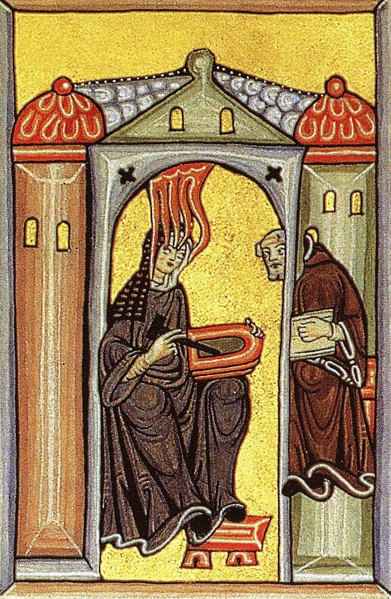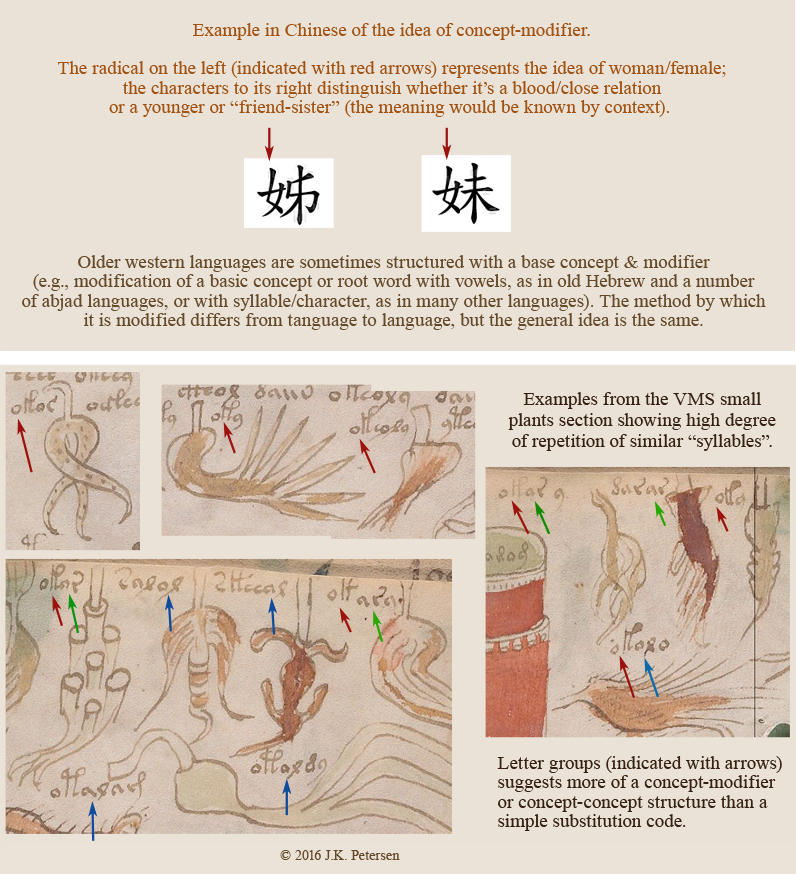6 May 2017
A discussion about the Voynich Manuscript zodiac pages (with examples by Marco Ponzi) came up today on the Voynich.ninja forum and I wanted to post something I’ve been sitting on for a while that relates to the structure of the VMS text.
I’ve selected some of the imagery from one of the small-plant pages and included an example from Chinese. This does not mean the underlying language is Chinese but that the structure of the VMS text is similar to quite a number of languages that have a syllabic structure that is based on concept-modifier or concept-concept in various combinations of simple building blocks. I think this structure argues against a basic substitution code but might enlighten how the manuscript is encoded.
If you look at various sections of the manuscript, you will see the same patterns. The VMS is written mostly in Latin characters and numerals (with some original shapes included), but the conceptual foundation (that of basic building blocks combined in similar ways for similar items), exhibits some of the structural characteristics of syllabic languages (or of a constructed/synthetic language).
 Constructed languages were not a novel idea in the middle ages. Magical languages have a long history, as do kabbalistic symbols as a means of communication. There are some interesting arguments that much of the Bible is allegorical and that there are numbers embedded in the text that provide secret information to those who are schooled in the hidden arts. Hildegard von Bingen created a cipher and partly constructed language in the 12th century.
Constructed languages were not a novel idea in the middle ages. Magical languages have a long history, as do kabbalistic symbols as a means of communication. There are some interesting arguments that much of the Bible is allegorical and that there are numbers embedded in the text that provide secret information to those who are schooled in the hidden arts. Hildegard von Bingen created a cipher and partly constructed language in the 12th century.
In the 17th century, John Dee had a strong interest in ciphers, symbols, and magical languages and expended considerable energy on recording them, and Athanasius Kircher developed a universal script in the hopes that communication could reach a wider audience.
But coming back to the Voynich Manuscript…
The VMS has many properties that suggest a constructed language or perhaps one that is a hybrid of natural and constructed language. I’ve remarked before on its singularly regimented style and seeming rigidity and its similarity to syllabic languages (anyone who has practiced their ba, be, bo, bu, and ma, me, mo, mu while studying Asian languages knows what I’m talking about).
The likelihood that the labels are names or regular nouns (as opposed to combinations of noun-concepts) seems low, given that no one has managed to decode them in a way that relates to the labels as a whole or illuminates any of the rest of the text. Anagramming the characters to come up with a handful of labels that look like words isn’t sufficiently convincing either. It seems more likely that the labels represent attributes or information about the items’ composition or use than the names of the items.
Will this unlock the information on the pages without illustrations?
The structure of the “labels” is similar to that of the main text, which also appears to be made up of simple building blocks and includes a high degree of repetition, but there are some additional dynamics in the longer passages that go beyond the kind of glyph-combinations that are in the labels. The very fact that many lines end with the same characters, characters that rarely appear midline, suggests an added level of complexity. Nevertheless, a better understanding of the labels might help unlock the rest.
J.K. Petersen
© Copyright 2016 J.K. Petersen, All Rights Reserved

